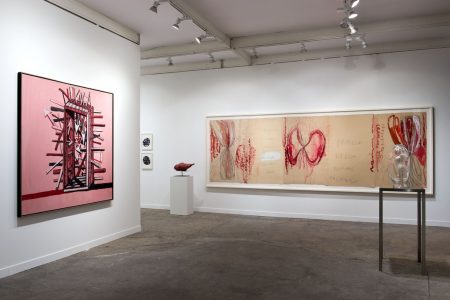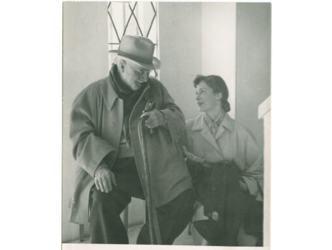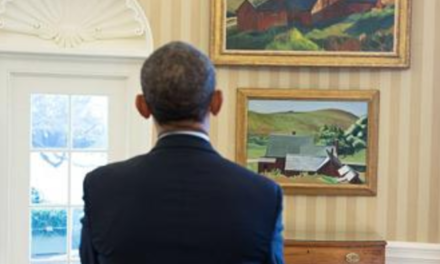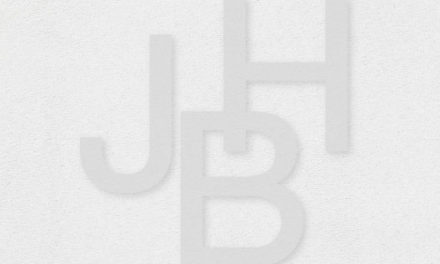In the race to extremes this year, the international contemporary art fair known as the Fiac (foire internationale d’art contemporain), now in its fortieth edition, is clearly returning to the fray.
Not in terms of the number of exhibitors – the glass dome of the Grand Palais is housing the Fiac’s 195 exhibitors until 21 October while Frieze in London had 260 and Art Basel even had 291 – but rather the kind of works on display.
While the bulk of the offerings can be found in the Grand Palais, various peripheral locations like the Petit Palais, the Place Vendôme, the Jardin des Tuileries and for the first time this year the Place de la Concorde, are also displaying works for sale.
Indeed, one of the stars of the 2018 edition of the fair has set up residence in the Jardin des Tuileries. It’s a sculpture by Alexander Calder (1898-1976) dating from 1969, a stabile / mobile with a red base and multicoloured floating structures rising to a height of 7.7 metres. A monument of lightness and grace.
It was the Christophe Van de Weghe gallery that brought it over from New York, where it had been on display in Gramercy Park. It is on sale for over 25 million dollars, which is probably the highest asking price at the Fiac.
The American artist’s rating has risen perceptibly in recent years and his record price of 26 million dollars was established in 2017. According to the director of the gallery, Pierre Ravelle-Chapuis, “we worked for two years to bring this piece to Paris. After negotiations with the Louvre, which owns the garden, it is now set to stay in the Tuileries and will be exhibited there for a year”.
A number of the galleries have gone to great efforts to display star artists in Paris during the Fiac.
In their vast gallery space at Le Bourget on the outskirts of Paris, the multinational Gagosian gallery is exhibiting some very impressive work, clearly at the behest of the artist himself, by one of the great legends of American contemporary art, Michael Heizer (born in 1944). He is known for his monumental artworks which make use of elements from nature.
At Le Bourget, a month of building works was required to bring this exceptional exhibition into being. It’s clear that the aim here was to make a lasting impression rather than a commercial calculation. Gagosian is also exhibiting a spectacular installation at the Fiac, conceived by Katharina Grosse (born in 1961) last winter at the Villa Medici.
She repurposed parasol pines, recently felled in the grounds of the Villa, to create a huge, multicoloured artwork, somewhere between painting and sculpture, composed of painted tree trunks and canvases placed on the ground. She spoke about it at the time.
The works on paper that accompany the installation are on sale for 30,000 euros.
A few paces from the Grand Palais, Kamel Mennour is exhibiting a new production in their space on Avenue Matignon by their recent recruit, the famous Scottish artist Douglas Gordon (born in 1966). There is a group of installations, including a neon work with a play on words, among others, which like the exhibition addresses the problems of alcoholism.
The neon work, a one-off piece, is on sale for 85,000 euros.
The Emmanuel Perrotin gallery is dedicating a solo show to the Scandinavian stars who live in Berlin, Elmgreen and Dragset. (They’ve been working together since 1995). They have discreetly filled the Place Vendôme with 100 bronze starfish placed on the ground, symbolizing the new challenges of climate change. At the gallery they address the issue of freedom in public space with, among other works, a road sign, a one-off piece where the instructions have been replaced by mirrored surfaces, on sale for 50,000 euros.
They explain the idea behind the exhibition.
At the Grand Palais, one of the major events this year is the return of the multinational gallery Hauser & Wirth.
Neil Wenman, senior director in London, justifies their participation in the fair after a three-year absence by the fact that the art scene in Paris has become vibrant again, and numerous collectors are said to be descending on the French capital.
Not far from a monumental photograph of Jeff Koons retaining no mysteries of the anatomies of both the artist and of la Cicciolina, which belongs to the neighbouring booth of David Zwirner and may well cause a scandal, in the Hauser & Wirth space, which coincidentally is on the theme of desire, an immodest Snow White in bronze lies on the floor like the American dreams.
It was made by Paul McCarthy (born in 1945), the Californian artist who debunks his own country’s myths (on sale for 750,000 dollars). Neil Wenman observes how during the Frieze fair in London business was flourishing, yet it was concentrated on secondary market artworks, in other words higher value works involving recognized artists, who are already at an advanced stage in their careers. On the morning of the opening of the Fiac a painting by Philip Guston and a large work on paper by Louise Bourgeois had already been sold for 6m and 2.5m dollars respectively.
In another genre , the galerie Art Concept was created in Paris by Olivier Antoine in 1992.
Antoine has what we call “flair” and frequently selects talents who, in the long term, go on to have international careers. This is the case for Ulla Von Brandenburg (born in 1974), a multidisciplinary artist of German origin who lives in Paris. Her work on the topic of Brexit is currently on display at the Whitechapel Gallery in London and she is due to exhibit at the Palais de Tokyo next year.
At the Fiac her colourful watercolours, which portray marginal or unusual figures, are on sale for 14,000 euros. It’s interesting to note that Art Concept doesn’t seem to favour gigantism, which is currently in vogue and a hit with the art market. Olivier Antoine, who employs three people, likens his job to that of organic farmers: “I don’t open branches everywhere. I don’t run real estate projects alongside my activities in the art trade. I try to have a reasonable carbon footprint.”
Something to think about.
Until 21 October. http://foire.fiac.com
Donating=Supporting

Support independent news on art.
Your contribution : Make a monthly commitment to support JB Reports or a one off contribution as and when you feel like it. Choose the option that suits you best.
Need to cancel a recurring donation? Please go here.
The donation is considered to be a subscription for a fee set by the donor and for a duration also set by the donor.





















